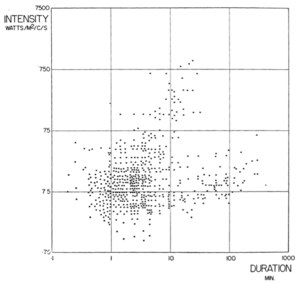The Post-Burst Increase
From RHESSI Wiki
(208 first bit) |
(208 part 2) |
||
| Line 44: | Line 44: | ||
brilliant loop prominence systems seen in Hα. | brilliant loop prominence systems seen in Hα. | ||
| - | + | The radio view became clear in 1958 (Ref. [1]), when [http://sprg.ssl.berkeley.edu/~tohban/wiki/index.php/Negative_Microwave_Bursts Covington] reported bimodality in the parameters of solar microwave bursts: the ones with long durations and small amplitudes, which we discuss in this Nugget, turn out to reflect | |
| + | strictly thermal ([http://www.cv.nrao.edu/course/astr534/FreeFreeEmission.html free-free]) emission process of the hot and cooling loops in the flare's coronal mass cycle. | ||
| + | Figure~1 shows this bimodality. | ||
| - | [[File:208f1.png| | + | [[File:208f1.png|300px|thumb|center|Fig. 1: An early (1958; see Ref. [1]) statistical view of the correlation between flux and duration for solar microwave bursts. |
The family with low fluxes and long durations comprises the post-burst increase (PBI) and gradual rise-and-fall (GRF) types. ]] | The family with low fluxes and long durations comprises the post-burst increase (PBI) and gradual rise-and-fall (GRF) types. ]] | ||
| + | |||
| + | == New Data == | ||
| + | |||
| + | Theoretically, the microwave thermal emission would make a flat spectrum, varying in frequency mainly via the [Gaunt factor] that describes the effect of screening on the basic electron-ion collisions; at the highest frequencies this flat spectrum would be supplemented by [free-bound] emission, and the whole spectrum would roll off exponentially as hν begins to exceed kT. | ||
| + | At the lowest frequencies other deviations could happen. | ||
| + | The plasma will become optically thick and/or absorb the free-free emission, or it could be supplemented as well by | ||
| + | [gyroresonance] if the plasma is sufficiently magnetic. | ||
| + | |||
| + | |||
| + | The whole-Sun data at fixed frequencies continue to the present, though supplemented by. | ||
== Conclusions == | == Conclusions == | ||
| + | |||
== References == | == References == | ||
| - | [1 | + | [1] [http://adsabs.harvard.edu/abs/1958JRASC..52..161C "Impulsive and Long-Enduring Sudden Enhancements of Solar Radio Emission at 10-cm. Wave-length"] |
| - | + | ||
| - | + | ||
[hugh-hudsons-macbook-pro-3:nuggets/2013/grf] hughhudson% | [hugh-hudsons-macbook-pro-3:nuggets/2013/grf] hughhudson% | ||
| + | |||
| + | [2] [http://adsabs.harvard.edu/abs/1985PASJ...37..575K "Directivity of radio emission from solar flares"] | ||
Revision as of 11:43, 30 September 2013
| Nugget | |
|---|---|
| Number: | |
| 1st Author: | Hugh Hudson |
| 2nd Author: | |
| Published: | September 30, 2013 |
| Next Nugget: | TBD |
| Previous Nugget: | Peristaltic Shocks: a model |
| List all | |
Contents |
Introduction
This Nugget follows Negative Microwave Bursts as a source of background information into the microwave literature, which new observations make highly relevant. Here we discuss the microwave bursts classified as "Post-Burst Increase" (PBI) and "Gradual Rise and Fall" (GRF, noting that this instead means something Jovian to German astronomers). These bursts are part of the traditional classification scheme for microwave radio bursts, based on fixed-frequency observations of the whole Sun. Nowadays we have microwave imaging spectroscopy, plus of course a myriad of other wavelengths to study, and so our knowledge needs some refreshment.
These slow burst types accompany the presence of new coronal material resulting from a flare. They closely match phenomena such as GOES soft X-ray bursts, flare arcades, loop prominence systems, and others. The coronal mass cycle of a flare consists of the injection of new material from the chromosphere below up into the corona, where it finds itself to be heated to X-ray temperatures. Nowadays the presence of the GOES event that shows this is almost the defining feature of a flare. Once in the corona, and following the cessation of impulsive energy release, the mass cools slowly and loses density back to its chromospheric reservoir, and then finally collapses into coronal rain as the hydrogen recombines - that is the source of the brilliant loop prominence systems seen in Hα.
The radio view became clear in 1958 (Ref. [1]), when Covington reported bimodality in the parameters of solar microwave bursts: the ones with long durations and small amplitudes, which we discuss in this Nugget, turn out to reflect strictly thermal (free-free) emission process of the hot and cooling loops in the flare's coronal mass cycle. Figure~1 shows this bimodality.
New Data
Theoretically, the microwave thermal emission would make a flat spectrum, varying in frequency mainly via the [Gaunt factor] that describes the effect of screening on the basic electron-ion collisions; at the highest frequencies this flat spectrum would be supplemented by [free-bound] emission, and the whole spectrum would roll off exponentially as hν begins to exceed kT. At the lowest frequencies other deviations could happen. The plasma will become optically thick and/or absorb the free-free emission, or it could be supplemented as well by [gyroresonance] if the plasma is sufficiently magnetic.
The whole-Sun data at fixed frequencies continue to the present, though supplemented by.
Conclusions
References
[1] "Impulsive and Long-Enduring Sudden Enhancements of Solar Radio Emission at 10-cm. Wave-length" [hugh-hudsons-macbook-pro-3:nuggets/2013/grf] hughhudson%
[2] "Directivity of radio emission from solar flares"
| RHESSI Nugget Date | 30 September 2013 + |
| RHESSI Nugget First Author | Hugh Hudson + |
